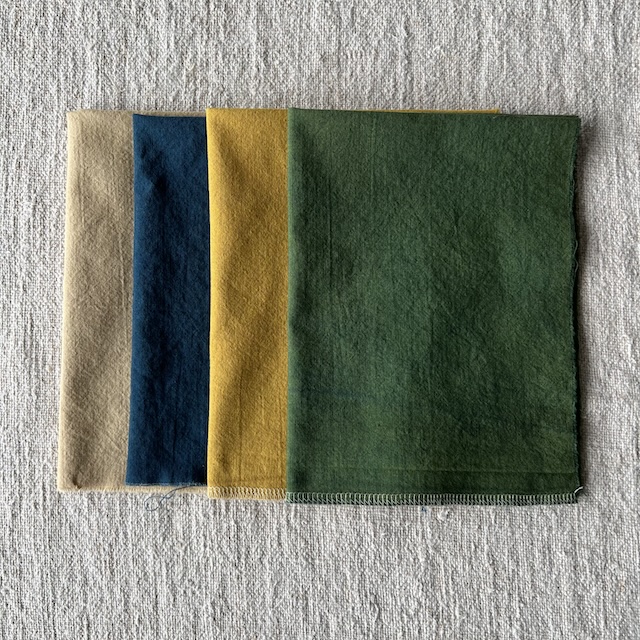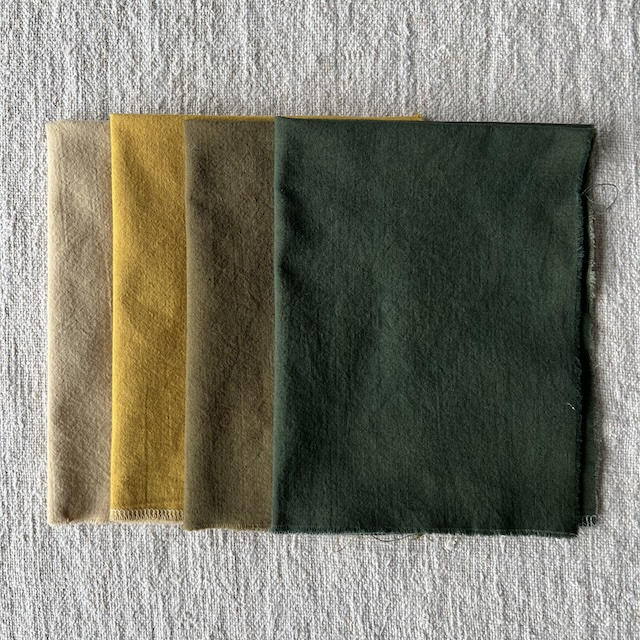
This week’s Mordant Monday focuses on Chestnut. We used Chestnut extract in our gradation and absolutely loved the combination of Chestnut, Fustic and Iron with Indigo.
This gradation is slightly different than our previous experiments. This time I did not overdye with a warm shade like Madder, to get corals and pinks. I wanted to focus on green and blue. Like previous examples, when a tannin is combined with other colors you can get exciting mixes and beautiful color blends that harmonize and are perfect for patchwork, creating gradations and stitching. If you are a yarn person, many of these combinations would look amazing together.
Skill level: Good for an intermediate dyer. You should be familiar with cellulose mordanting, using iron as a post-bath, and dyeing with natural dye extracts.
The inspiration for using Chestnut comes from Sara Buscaglia of Ancient Futures Farm and author of the book Farm & Folk Quilt Alchemy (we have signed copies!) In her book, Sara beautifully articulated some ideas that I’d been mulling over and when I saw the results she achieved, I knew we should dive in and start testing colors. It’s been a lot of fun!
Here are some ideas to get you started. We are dyeing with a variation of the traditional tannin-alum cellulose mordant recipe and used Chestnut in place of the traditional Gallo Tannin. The addition of our first over dye created a bright egg yolk yellow, which set the stage for some gorgeous greens. Chestnut alone with Indigo made for a really beautiful warm blue.
The entire gradation using Chestnut, Fustic, Iron and Indigo.

Pictured here from top to bottom: Chestnut, Chestnut with Fustic, Chestnut with Fustic with Iron Post Bath, Chestnut with Fustic with Indigo Dip, Chestnut with Fustic with Iron Post Bath and Indigo dip, and the blue is Chestnut with Indigo.
Chesnut and Indigo – the first over dye

Pictured here are Chestnut mordanted sample over dyed with Dark Indigo, then Chestnut over dyed with Fustic, then finally Chestnut and Fustic over dyed with dark Indigo
Start with 6 pieces of cotton, each approximately the size of a fat quarter (18×22 inches)
Scour cotton fabric, using our scour recipe
Then follow our tannin-alum mordant recipe using Chestnut in place of the traditional Gallo Tannin. Mordant fabric with 10% Chestnut and soak for 1 hour. Then create an alum mordant bath with 15% aluminum sulfate or aluminum potassium sulfate and 1.5% soda ash. Soak the fabric in this bath for 1 hour.
You will have 6 pieces of Chestnut mordanted fabric. Reserve one piece as the original Chestnut Color, rinse well, dry and set it aside.
Take a second piece of Chestnut mordanted fabric and set it aside to be dipped in dark indigo to create the beautiful warm blue. Since you will be dipping two other pieces in dark indigo later, you can set this piece aside and dip everything at once. It helps to label it so you know what to do with it once you reach the indigo phase.
Take the remaining 4 pieces of Chestnut mordanted fabric and dye them with Fustic at 10%. You should get a rich yellow, brighter than what I normally dye, and this bright yellow will be the key to a really nice green.
Reserve one piece of the bright yellow Fustic color, rinse and dry.
Chestnut, Fustic, Iron (and Indigo) combination

Pictured here are the Chestnut mordanted fabric, Chestnut with Fustic over dye, Chestnut with Fustic and Iron post bath, and Chestnut with Fustic, Iron post bath and an Indigo dip
Take two of the bright yellow Fustic dyed pieces and dip them in a room temperature iron post-bath. I was going for a khaki olive tone, so I used 2.5% iron on the weight of my fabric, dissolved it in a small stainless pan and then dipped both pieces until they changed color. I left them in the bath about 20 minutes total, then removed them, rinsed the fabric very well and set one piece aside to dry.
At this time, you should have 1 chestnut dyed piece, 1 bright yellow, and 1 iron post-bath dyed piece remaining. All of these will be dipped into a dark indigo vat. The chestnut piece will turn blue, the bright yellow piece will turn deep green, and the iron bath piece will turn dark forest green. Once these pieces are dipped, oxidize them and rinse well. Dry and assemble your beautiful Chestnut gradation!
Ingredients we used in this gradation
Mordanted Bandana 6-Pack makes it easy to dive into color experiments!
Notes:
- Rinse fabrics after mordanting, dyeing, and the iron post-dip, and air dry away from direct sunlight.
- We like to dip all indigo pieces at least twice. If your vat is super dark, plan on two short dips so that the color is even.

These are such lovely colors. I’m eager to try this but a little worried. The only time I over dyed with my iron indigo vat, I stripped the dye. Is it my vat perhaps? Or are tannins less likely to strip? Thank you for your always interesting posts.
We’ve not tried this overdye exercise with a ferrous vat, but if you’re worried about the effect of the iron vat on the colors, perhaps you might try dipping the samples in indigo first. Dip the dark, medium and light, oxidize, then rinse well. Then move to adding in the mordant colors. Your results may vary from ours, but I think you will still get great shades. Have fun with this!